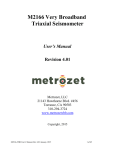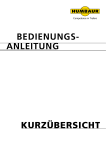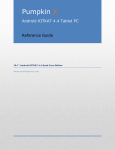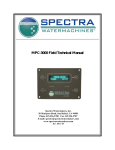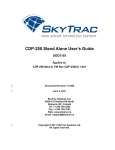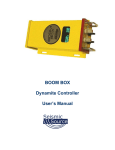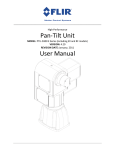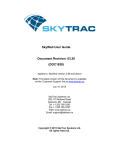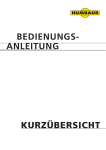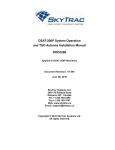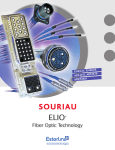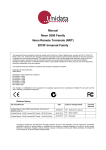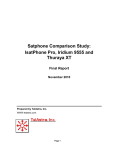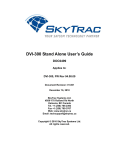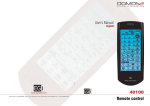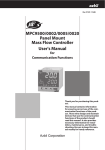Download ISAT-100 Specifiations, Operating Instructions and Install
Transcript
ISAT-100 Specifiations, Operating Instructions and Install Manual ISAT-100-OPD-SOI Applies to: ISAT-100 Mod A Document Revision: 01.048 September 08, 2006 SkyTrac Systems Ltd. 200-170 Rutland Rd N. Kelowna, BC Canada V1X 3B2 Tel. (250) 765-2393 Fax (250) 765-3767 Web: www.skytrac.ca Email: [email protected] Copyright © 2005 SkyTrac Systems Ltd. All rights reserved. Page 1 of 31 SkyTrac Systems Ltd. Proprietary Notice: The Information contained in this document is proprietary and confidential to SkyTrac Systems Ltd. Document Revision History Rev ECO Page 01.20 - Description Initial Release Date July 2003 Approval KWallace 01.30 012 Amendment to Install Notes: Added upright mounting requirement and vent hole requirements. Amendment to Install Notes: Added paragraph on potential Hydrogen release rate, suggested install space and ventilation requirements. Amendment to Environmental Test Summary: Section 9 and 22 Comments: Note 1. Amendment to Continued Airworthiness: Periodic inspection notes Amendment to Overview: Added point 9 regarding PDA usage. Amendment to Operating Temperature Amendment to EMI Test to be consistent with EMI/RFI Test for ISAT-100 (Doc # 238-50064-00) Amendment to DO-160D: Corrected DO-160D Category Amendment to Operating Temperature DO-160D: Section 4.5 Add Category A4 Revised second line to read “Equipment near active INMARSAT terminals” Sept 18, 2003 KWallace Oct 14, 2003 KWallace Oct 16, 2003 KWallace Oct 16, 2003 KWallace Nov 7, 2003 KWallace Nov 18, 2003 KWallace Nov 18, 2003 KWallace Nov 18, 2003 KWallace Nov 20, 2003 KWallace Nov 20, 2003 KWallace Mar 3, 2004 KWallace S 4.6 - S 4.6 - S 2.7 - S 2.8 - S 4.5 - S 2.1 - S 4.8.2 - S 1.2 - S 2.1 - S 2.7 - S 4, A-B Pg 26 Document Rev. 01.048 ISAT-100-OPD-SOI Restricted Proprietary and Confidential Information Page 2 of 31 SkyTrac Systems Ltd. Document Revision History Continued Rev ECO Page S 1.4, Pg 6, S 2.3, 2.4, Pg 7, S 4.5, Pg 10, S 4.7, Pg 18 Fig 4-2, Appendix A REAR Pg 8 * 01.40 019 - S 4.6.1, Pg 14 Table 4.1, Pg 16 S 4.6.1 Fig 4.3 S 4.8 Fig 4.5 S 4.6 Fig 4-2, S 4.6.1 Fig 4-4, Table 4-2 01.41 01.42 01.43 022 026 01.44 - Pg 1. Pg 6, Pg 14, Pg 8, 01.45 - P12 01.46 - Pg 13 01.47 027 All Description Change discussion from two separate antennae to one combination antenna Date Apr 13, 2004 Approval KWallace Both modified to illustrate connecting to one combination antenna * FAA Policy # 2001-01 Separate FADEC not required Amendment to Data Connector Diagram and Pin Description Specified Pin J as Mission Switch Apr 13, 2004 KWallace June 1, 2004 KWallace Aug 19, 2004 KWallace Aug 19, 2004 KWallace Dec 16, 2004 KWallace Jan 5, 2005 KWallace Updated Connector Diagram according to Table 4.1 Updated Connector Pinout Updated 10-Pin Connector Pinout & Jan 20, 2005 Description Table KWallace Updated Document Formatting ISAT Rev 01.80 Release Added instructions for identifying the ISAT hardware version.. Added GPS not for navigational purposes notice. Remove reference to non existing section. Added installation requirement that system connectors must be connected before system power is applied. Added instructions for determining which Mod the ISAT is. Updated SOI format implemented Additional details on Maintenance and Continued Airworthiness, and Airworthiness Limitations were added. Feb 1, 2005 Feb 15, 2005 Apr 27, 2005 KWallace G. Pringle G.Pringle May 30, 2005 K.Wallace Document Rev. 01.048 ISAT-100-OPD-SOI Restricted Proprietary and Confidential Information Page 3 of 31 SkyTrac Systems Ltd. Document Revision History Continued Rev ECO 01.048 088 Page 1, 5 Description Updated Address Date Sept-08-06 Document Rev. 01.048 ISAT-100-OPD-SOI Restricted Proprietary and Confidential Information Approval T.Ratch Page 4 of 31 SkyTrac Systems Ltd. Warning Changes or modifications not expressly approved by SkyTrac Systems Ltd. could void the user’s authority to operate the equipment. Warranty Information SkyTrac Systems Ltd (STS) warrants this product to be free of defects in materials and workmanship, and that the product meets or exceeds approved factory acceptance test requirements. STS reserves the right to replace any warranted product at its sole discretion during the warranty period. The Model ISAT-100 Airborne Data/Position Communicator is under warranty for one year from date of purchase. Failed units caused by defective parts, or workmanship should be returned to: SkyTrac Systems Ltd. 200-170 Rutland Rd. N Kelowna, B.C. Canada V1X 3B2 Document Rev. 01.048 ISAT-100-OPD-SOI Restricted Proprietary and Confidential Information Page 5 of 31 SkyTrac Systems Ltd. Table Of Contents 1 GENERAL .....................................................................................................................................8 1.1 1.2 1.3 1.4 2 INTRODUCTION ........................................................................................................................8 DESCRIPTION ..........................................................................................................................8 PURPOSE OF EQUIPMENT .......................................................................................................8 SYSTEM REQUIREMENTS ........................................................................................................9 SPECIFICATIONS .....................................................................................................................10 2.1 PHYSICAL PROPERTIES ........................................................................................................10 2.2 TECHICAL SPECIFICATIONS...................................................................................................10 2.2.1 GPS Receiver .............................................................................................................10 2.2.2 ISAT-100 Combination Antenna ..............................................................................10 2.2.3 Satellite Transceiver ..................................................................................................11 2.3 EMISSIONS COMPLIANCE ......................................................................................................11 2.4 ENVIRONMENTAL TEST SUMMARY........................................................................................12 3 AIRWORTHINESS LIMITATIONS..........................................................................................13 3.1 3.2 4 INSTALLATION LIMITATIONS...................................................................................................13 OPERATION LIMITATIONS ......................................................................................................13 INSTALLATION INSTRUCTIONS ..........................................................................................14 4.1 INSTALLATION REQUIREMENTS .............................................................................................14 4.2 UNPACKING AND INSPECTING ...............................................................................................14 4.2.1 Identifying Your ISAT.................................................................................................14 4.2.2 Equipment Packing Log ............................................................................................14 4.2.3 Installation Kit - Contents ..........................................................................................14 4.3 OVERVIEW .............................................................................................................................15 4.4 ISAT-100 INSTALLATION ......................................................................................................15 4.4.1 Pin Locations and Connections ...............................................................................17 4.5 ANTENNA INSTALLATION .......................................................................................................23 4.6 PROGRAMMING PORT ...........................................................................................................24 4.7 POST INSTALLATION TESTS ..................................................................................................25 4.7.1 Function Test ..............................................................................................................25 4.7.2 EMI Test.......................................................................................................................25 5 OPERATING INSTRUCTIONS................................................................................................27 5.1 5.2 6 OPERATING INSTRUCTIONS ..................................................................................................27 ACTIVATION ...........................................................................................................................27 MAINTENANCE AND CONTINUED AIRWORTHINESS ...................................................28 6.1 6.2 CONTINUED AIRWORTHINESS ...............................................................................................28 MAINTENANCE INSTRUCTIONS ..............................................................................................28 Document Rev. 01.048 ISAT-100-OPD-SOI Restricted Proprietary and Confidential Information Page 6 of 31 SkyTrac Systems Ltd. 7 APPENDIX A ..............................................................................................................................29 7.1 7.2 8 ISAT-100 FRONT PANEL DIAGRAM .....................................................................................29 ISAT-100 REAR PANEL DIAGRAM .......................................................................................30 APPENDIX B ..............................................................................................................................31 8.1 8.2 CAUSES OF RF INTERFERENCE ............................................................................................31 MITIGATION OF RF INTERFERENCE ......................................................................................31 Document Rev. 01.048 ISAT-100-OPD-SOI Restricted Proprietary and Confidential Information Page 7 of 31 SkyTrac Systems Ltd. 1 1.1 GENERAL Introduction This publication provides technical information for the ISAT-100 Position/Data Communicator (Mod A), developed by SkyTrac Systems Ltd. The ISAT-100 will provide position reporting and messaging with global coverage in near real time. 1.2 Description The ISAT-100 contains a GPS (Global Positioning System) receiver, an L-Band transceiver specifically designed to communicate with the Iridium® satellite system, a battery which enables communications with the satellite system after airframe power shutdown and a battery charging system. Control and interfacing is provided with a low power single-board computer. The ISAT-100 is compliant with RTCA DO-160D environmental category Cat. [(A4)(D1)]XAB[(SMB)(UF)]XXXXXXZBBXXXHXXXX and carries an airworthiness approval. Appendix A illustrates the Front and Rear Panel layout of the ISAT-100. 1.3 Purpose of Equipment The ISAT-100 is the primary hardware component of a system designed to provide automatic message reporting, 2-way messaging and other data transfers between an aircraft and any point in the world having Internet access, via the Iridium® Low Earth Orbit (LEO) satellites. Present position and text messages from the aircraft can be displayed on any computer with Internet access and SkyTrac software. Position reporting intervals are user defined. Base software displays current and historical position data including latitude, longitude, GPS time, relative position (to a known way point), ground speed, altitude and heading, in tabular format and on a map. Airtime, flight time, ETA, distance traveled, time elapsed and other flight data is also displayed for instant viewing. Flight reports can also be generated by unit and time frame (i.e. airtime/flight time per day/week/month). Operationally, the ISAT system can compliment flight following requirements for commercial operators and provide vital position data and messaging services to those operators conducting flight activities in remote areas. Document Rev. 01.048 ISAT-100-OPD-SOI Restricted Proprietary and Confidential Information Page 8 of 31 SkyTrac Systems Ltd. 1.4 System Requirements 1.5 The ISAT system must receive GPS signals to enable the determination of its present position and communicate (send/transmit) with the Iridium® LEO satellite system. A Windows-based PC and a dedicated email address are required at the Base Location. Minimum Operating System Requirements for SkyTrac Base Software Windows 2000® OS Pentium Type Processor – 500 MHz 64 Megabytes of RAM 350 Megabytes of Hard Disk Space Email connection with POP3 and SMTP CD-ROM drive − Video Card capable of High Colour (16-bit) display Display setting must be set to High Colour (16-bit) or better. This setting can be found in Start ► Settings ► Control Panel ► Display Settings, or right-click on your desktop select Properties ► Settings Tab. − − − − − − Document Rev. 01.048 ISAT-100-OPD-SOI Restricted Proprietary and Confidential Information Page 9 of 31 SkyTrac Systems Ltd. 2 2.1 SPECIFICATIONS Physical Properties Operating Temperature Size Weight Power Requirement Mounting 2.2 -15ºC to +55ºC (RTCA DO-160D) -40ºC to +65ºC (manufacture test) 10” (L) excluding connectors, 3.5” (H) 4.2” (W) plus 1.5 “ bottom mounting flange 2.3 kg (5.07 lbs) Nominal standard 28VDC system bus via 3 Amp breaker. *Actual consumption is 0.5 Amp typical, 1.5 Amp while transmitting. Equipped with reverse voltage and transient protection. 6 x 3AN bolts, flange mount horizontally with mounting brackets on the bottom. Normal air circulation required: Do not cover vent holes in top cover or in sides (2) of unit. Techical Specifications 2.2.1 GPS Receiver Receiving Method Acquisition time Position accuracy Acceleration 12 Channel, Parallel Receiver 48 seconds after power up (cold start) 0.1 seconds for re-acquisition. Less than 25 m without Differential GPS 1-5m with Differential GPS - WAAS enabled 4 G max 2.2.2 ISAT-100 Combination Antenna Active L1 GPS/Passive Iridium Antenna, low profile, moulded radome. Height: 0.721 in. (18.31 mm) Length: 5.026 in. (127.66 mm) Width: 2.0 in. (55.88 mm) Weight: 8.0 oz (226 g) Voltage: 3.0 to 28.0 VDC @ 50 mA max Gain (GPS antenna): 32dB min The Iridium® satellite serving a Short Burst Data call can literally be anywhere in orbit at a given moment in time. For this reason, it is imperative that the antenna be mounted outside, as high as possible, in a horizontal position on the aircraft, attempting to achieve a 360-degree view of the sky with minimal obstructions. Document Rev. 01.048 ISAT-100-OPD-SOI Restricted Proprietary and Confidential Information Page 10 of 31 SkyTrac Systems Ltd. 2.2.3 Satellite Transceiver Operating frequency *Power consumption 1616 MHz to 1626.5 MHz Transmit (max) 7W *The ISAT-100 is not classified as “Equipment known to have a high potential for interference” in accordance with FAA Policy No.: ASW-2001-01 dated April 25, 2002. Separate FADEC testing is not required for this installation. 2.3 Emissions Compliance Entity US FCC US FCC ETSI Document Title Title 47 Code of Federal Regulations Title 47 Code of Federal Regulations 1997 Satellite Earth Stations and Systems (SES); Harmonized EN for Document Number Section 15.109 Section 25.202 EN 301 441 Document Rev. 01.048 ISAT-100-OPD-SOI Restricted Proprietary and Confidential Information Page 11 of 31 SkyTrac Systems Ltd. 2.4 Environmental Test Summary The following table summarizes DO-160D Environmental Testing for the SkyTrac ISAT-100 Airborne Position/Data Communicator. Section of DO-160D 4.5 4.6, 4.6.2 6.0 7.0 8.0 9.0 10.0 11.0 12.0 13.0 14.0 15.0 16.0 17.0 18.0 Condition Temperature & Altitude Rapid decompression Humidity Operational Shock and Crash Safety Vibration 1) Category Comments [A4, D1] Meets category requirements A B Meets category requirements Meets category requirements SMB/UF Meets fixed wing standard vibration, helicopter robust vibration No test required. See Note 1. No test required No test required No test required No test required No test required <0.3m for 1 degree deflection Meets category requirements Meets category requirements No test required Explosion Proofness X Waterproofness X Fluid Susceptibility X Sand and Dust X Fungus Resistance X Salt Spray X Magnetic Effect Z Power Input B Voltage Spike B AF Conducted X Susceptibility 19.0 Induced Signal X No test required Susceptibility 20.0 RF Susceptibility X No test required 21.0 RF Emissions H Meets category requirements 22.0 Lightning Induced X No test required. See Note 1. Transient Susceptibility 23.0 Lightning Direct Effects X No test required 24.0 Icing X No test required 25.0 ESD X No test required Note 1: Analysis provided to Transport Canada meets category requirements. Document Rev. 01.048 ISAT-100-OPD-SOI Restricted Proprietary and Confidential Information Page 12 of 31 SkyTrac Systems Ltd. 3 3.1 AIRWORTHINESS LIMITATIONS Installation Limitations The following installation regulations must be adhered to: • The ISAT-100 must be installed with the attached mounting brackets on the bottom to insure proper ventilation of the ISAT unit (see section 2.1 for details). • The ISAT-100 must be installed in a location that provided adequate ventilation space, as specified in section 4.4. 3.2 Operation Limitations GPS Information provided by ISAT not intended for navigational purposes. Document Rev. 01.048 ISAT-100-OPD-SOI Restricted Proprietary and Confidential Information Page 13 of 31 SkyTrac Systems Ltd. 4 INSTALLATION INSTRUCTIONS IMPORTANT NOTICE: All system interconnect cables must be connected before power is applied to the system. 4.1 Installation Requirements When installing the ISAT-100 the installer must have a working knowledge of aircraft electronics installation, and be a holder of either an FAA Repairman’s Certificate or a Transport Canada equivalent. All installations should meet the requirements of FAA advisory circular AC43.13-1B. 4.2 Unpacking and Inspecting 4.2.1 Identifying Your ISAT If the ISAT has a Mod A Label, then this installation manual applies to the ISAT. If the ISAT does not have a MOD A label, please use the version of this manual appropriate for your ISAT. 4.2.2 Equipment Packing Log Save the original shipping container in case of need for return due to damage or warranty claims. Check that each item listed on the packing slip has been shipped in the container. Verify and record the IMEI Number of the ISAT-100. This information is required when contacting SkyTrac Systems to activate the satellite communications services. 4.2.3 Installation Kit - Contents The ISAT-100 Installation Kit (P/N 010000-2) consists of the following: ISAT Installation Kit (P/N 010000-2) Parts List 2 2 1 1 SMA Male Connector (crimp type) for RG-400 or equivalent low-loss coaxial cable with 0.200” O.D. TNC Male Connectors (crimp type) for RG-400 or equivalent low-loss coaxial cable with 0.200” O.D. Circular MS Bayonet Lock Connector, Straight Plug with Strain Relief (MIL-C-26482, Series 1), such as Amphenol MS3126F12-10S or Souriau 851-06RC12-10S50 Circular MS Bayonet Lock Connector, Straight Plug with Strain Relief (MIL-C-26482, Series 1), such as Amphenol MS3126F14-19S or Souriau 851-06RC14-19S50 Document Rev. 01.048 ISAT-100-OPD-SOI Restricted Proprietary and Confidential Information Page 14 of 31 SkyTrac Systems Ltd. 4.3 Overview The main tasks for this installation are listed below: 1. Check the contents of the installation kit (P/N 010000-2) against those listed in Section 4.4 of this manual. 2. Determine the approximate location of the ISAT-100, combination GPS/Passive Iridium antenna. Note: Factors to be considered to determine install location include maximum antenna coax lengths and minimum distance between existing GPS and ISAT-100 combination antenna. If ISAT-100 is to be installed near an active INMARSAT terminal or if the aircraft that the ISAT-100 is installed in operates near an active INMARSAT terminal please see Appendix B. 3. Mount the ISAT-100. 4. Mount the ISAT-100 combination antenna. 5. Route the coax cables for Iridium and GPS antenna signals to the ISAT-100 combination antenna. 6. Create the wire harness for the ISAT-100. 7. Check the data port using a PDA loaded with ITrax software, as per ITrax user manual (P/N MAN-TRAX-001). 8. If a PDA is used: • Make sure it has a serial connector • RS 232 cable should not exceed 40 ft. o Must use shielded RS 232 cable 4.4 ISAT-100 Installation The ISAT-100 is designed to be secured by its mounting rails to the airframe using six (6) AN-3 bolts and should be installed using the ISAT installation kit (P/N KIT-ISAT100). Figure 4-1: ISAT-100 Mounting Rails illustrates the locations for mounting screws in the mounting rails on the sides of the ISAT-100. It is important to achieve a good electrical bond between the ISAT-100 enclosure and the airframe. Remove paint if necessary and prepare the mounting holes. Document Rev. 01.048 ISAT-100-OPD-SOI Restricted Proprietary and Confidential Information Page 15 of 31 SkyTrac Systems Ltd. FIGURE 4-1 ISAT-100 Mounting Rails Important Note: The ISAT-100 contains a sealed lead-acid battery as a backup power source. Under extreme fault conditions, this device may release Hydrogen gas at a rate of up to 0.84 in3 per minute. The installer must install this device in an area with sufficient ventilation and comply with FAR 29.1353 (c) for the final installation design. The ISAT-100 must be mounted in an upright position and none of the venting holes in the top cover or in either side panel should be covered at any time. The free air volume around the ISAT-100 installation must be at least 8 cubic feet. Like any other transmitter, the ISAT-100 should be installed as far from aircraft apertures (such as windows) and as far from radio receiver antennae as practical. Figure 4.2 illustrates the Block Diagram for the ISAT-100. Document Rev. 01.048 ISAT-100-OPD-SOI Restricted Proprietary and Confidential Information Page 16 of 31 SkyTrac Systems Ltd. FIGURE 4-2 ISAT-100 Block Diagram 4.4.1 Pin Locations and Connections The identification letters and descriptions for the 19-pin System Connector and 10-pin Data Connector, located on the front of the ISAT-100, are listed in Tables 4-1 and 4.2 and illustrated in Figures 4-3 and 4.4 respectively. Both Pin B and Pin C on the System connector must be grounded in order to enable the internal battery. Use AWG 20 wire to hook up the 28VDC aircraft main power source protected through a 3 Amp breaker to the ISAT-100. It is important to remember that the ISAT100 will sense the onrush of 28VDC and will send this event, together with a timestamp, to the dispatch centre in order to signal the beginning of a flight. Thus, the ISAT-100 should receive mains power as soon as the aircraft’s master or avionics switch is turned on. The remaining Pins on J1 are reserved for future firmware implementations. Document Rev. 01.048 ISAT-100-OPD-SOI Restricted Proprietary and Confidential Information Page 17 of 31 SkyTrac Systems Ltd. FIGURE 4-3 System Connector Diagram Document Rev. 01.048 ISAT-100-OPD-SOI Restricted Proprietary and Confidential Information Page 18 of 31 SkyTrac Systems Ltd. Table 4-1 System Connector - Pin Description 19 Pin System Connector Pin # Description A +28 VDC Main Power In B Ground (Power) C Battery Disconnect D Analog Input #1 0-30VDC E Analog Input #2 0-30VDC F Analog Input #3 0-30VDC G Analog Input #4 0-30VDC H Analog Input #5 0-30VDC J Voltage Seeking - Digital Input #1 (Mission Switch) K Voltage Seeking - Digital Input #2 L Ground Seeking - Digital Input #3 M Voltage Seeking - Digital Input #4 N Ground Seeking - Digital Input #5 (Squat Switch) P Voltage Seeking - Digital Input #6 (Engine On/Off) R Ground Seeking - Digital Input #7 (Emergency) S Current Sinking Digital Output #1 T Current Sinking Digital Output #2 U Current Sinking Digital Output #3 V Differential GPS Input The above digital inputs on Pin N, P & R are set as factory default. Contact SkyTrac if different configuration is required. Document Rev. 01.048 ISAT-100-OPD-SOI Restricted Proprietary and Confidential Information Page 19 of 31 SkyTrac Systems Ltd. System Connector –Pin Descriptions (Detailed) Pin A +28 VDC Main Power In This is the main power supply to the ISAT-100. The operating range is 18 - 30VDC Pin B - Ground (Power) This is the power ground connection for the ISAT-100. Pin C - Battery Disconnect Connect pin C to pin B or ground to enable the ISAT-100’s internal battery. This feature allows the ISAT-100 with the connector removed to be placed in storage for several months without completely draining the internal battery, which could otherwise result in damage. Pin D - Analog Input #1 An analog voltage level between 0 and +30 volts, when applied to pin D, will be converted to a digital value with 12 bits of resolution. Pin E - Analog Input #2 An analog voltage level between 0 and +30 volts, when applied to pin E, will be converted to a digital value with 12 bits of resolution. Pin F - Analog Input #3 An analog voltage level between 0 and +30 volts, when applied to pin F, will be converted to a digital value with 12 bits of resolution. Pin G - Analog Input #4 An analog voltage level between 0 and +30 volts, when applied to pin G, will be converted to a digital value with 12 bits of resolution. Pin H - Analog Input #5 An analog voltage level between 0 and +30 volts, when applied to pin H, will be converted to a digital value with 12 bits of resolution. Pin J - Digital Input #1 – Voltage Seeking - (Mission) A positive input between 5V and 28V, when applied to pin J, will produce a digital logic high. Pin K - Digital Input #2 - Voltage Seeking A positive input between 5V and 28V, when applied to pin K, will produce a digital logic high. Pin L - Digital Input #3 - Ground Seeking A ground input when applied to pin L, will produce a digital logic high. Document Rev. 01.048 ISAT-100-OPD-SOI Restricted Proprietary and Confidential Information Page 20 of 31 SkyTrac Systems Ltd. Pin M - Digital Input #4 - Voltage Seeking A positive input between 5V and 28V, when applied to pin M, will produce a digital logic high. Pin N - Digital Input #5 -Ground Seeking (Squat switch) Grounding pin N will produce a digital logic high. The default configuration uses pin N to monitor the aircraft’s squat switch. Pin P - Digital Input #6 - Voltage Seeking (Engine on/off) A positive input between 5V and 28V, when applied to pin P, will produce a digital logic high. The default configuration uses pin P to monitor the aircraft’s engine (on/off). Pin R - Digital Input #7 - Ground Seeking (Emergency) Grounding pin R will produce a digital logic high. The default configuration uses pin R to monitor an emergency or panic switch. Pin S- Digital Output #1 –Current Sinking The default use for Digital output #1 is to indicate a message in the pilot’s inbox. This output has been configured as a sinking output and can sink up to 200mA at 30VDC. Pin T - Digital Output #2 –Current Sinking The default use for Digital output #2 is to indicate an overdue position report. This output has been configured as a sinking output and can sink up to 200mA at 30VDC. Pin U – Digital Output #3 - Current Sinking Pin S is a sinking digital output. This output has been configured to sink up to 200mA at 30VDC. Pin V - Differential GPS Input Pin V is an RS-232 Differential GPS (DGPS) input. Use shielded AWG 22, or smaller, cable to make up a serial cable for a PDA or computer connection. Use pin A, B, and C for default set-up. Connect pin B to pin 2 and pin C to pin 3 on a male DB 9 connector for a PDA device. Switch pin 2 and pin 3 for a female DB9 computer connection. The remaining pins on J2 are reserved for special firmware implementation. Document Rev. 01.048 ISAT-100-OPD-SOI Restricted Proprietary and Confidential Information Page 21 of 31 SkyTrac Systems Ltd. Figure 4-4 Data Connector Diagram Table 4-2 Data Connector Pin Description 10 Pin Data Connector Pin # A Description D E F G H J Ground (Signal) RS-232 Channel #1 – Transmit (use this channel to connect PDA) RS-232 Channel #1 – Receive (use this channel to connect PDA) RS-232 Channel #2 - Transmit RS-232 Channel #2 - Receive RS-485 Channel #1 - Negative RS-485 Channel #1 - Positive Voice Ground Voice Speaker K Voice Microphone B C Document Rev. 01.048 ISAT-100-OPD-SOI Restricted Proprietary and Confidential Information Page 22 of 31 SkyTrac Systems Ltd. 4.5 Antenna Installation Active L1 GPS Passive Iridium Antenna (P/N: STS-ISAT-ANT) The standard ISAT-100 installation will use a combination, active L1 GPS/Passive low profile, molded radome, Iridium antenna (P/N: STS-ISAT-ANT). This recommended system antenna is only available directly from SkyTrac Systems Ltd. Please contact SkyTrac Systems to discuss the feasibility of using alternate antenna, if required. The combination antenna must be installed at least three feet away from any other GPS antenna. It is imperative that the antenna be mounted outside, as high as possible and in a horizontal position on the aircraft, attempting to achieve a 360degree view of the sky with minimal obstructions. IMPORTANT NOTE: This antenna uses SMA connectors for the GPS jack and TNC connectors for the L-Band or Iridium jack. Immediate damage will occur to the ISAT-100 if either cable is connected to the wrong jack. The use of RG-400 low-loss coaxial cable restricts the maximum length of the cable to 18 ft. If a longer run is required, use lower loss coax cable like ECS 310801, 311601, 311501, 311201 and refer to manufacturers specs for attenuation at 1.6 GHz. Attenuation of equal or less than 3dB is required. The bond between the airframe and the antenna needs to be 10 milliohms or less. Prepare the mounting location by drilling holes in the aircraft skin or through a mounting plate. Use a doubler plate of 4 x 6 inches if antenna is installed on a nonmetallic aircraft surface to create a ground plane. The plate must have an electrical connection to the antenna ground. Installation of an antenna on the aircraft should be performed only as defined by the aircraft manufacturer or in accordance with TC or FAA approved engineering data. Special caution must be observed when installing antennae in pressurized aircraft. Note: The ISAT combination antenna includes a rubber seal that must be properly installed into the groove on the underside of the antenna prior to mounting the antenna. This seal acts as an environmental seal from the outside atmosphere. Any connections that are not protected from the outside atmosphere by the rubber antenna seal should have an environmental seal applied to them during installation. Document Rev. 01.048 ISAT-100-OPD-SOI Restricted Proprietary and Confidential Information Page 23 of 31 SkyTrac Systems Ltd. 4.6 Programming Port The programming port (Figure 4-5) is used to install new or revised firmware in the ISAT-100. SkyTrac Systems will issue a PC executable file that will perform any upgrade. A standard serial DB9 computer cable (RS-232) will be required to connect a laptop or PC to the ISAT-100. Figure 4-5 Programming Port (Rear Panel) Document Rev. 01.048 ISAT-100-OPD-SOI Restricted Proprietary and Confidential Information Page 24 of 31 SkyTrac Systems Ltd. 4.7 Post Installation Tests 4.7.1 Function Test The avionics installer must perform this test immediately after installation. a) Move aircraft to a location with unrestricted visibility of the sky. b) Turn on aircraft master/avionics switch. Power and Charge LED should light up immediately followed by the BAT, MDM and GPS LED. Note that it may take up to 2 minutes for the GPS LED to light up, as the GPS has to lock on to at least 2 satellites. c) Connect the PDA with SkyTrac ITrax software to the ISAT-100 Data Port using the Data Cable. In the ITrax software verify communication with the PDA and verify valid GPS time displayed on the PDA. For more information, please refer to ITrax user manual (P/N MAN-TRAX-001) Turn master/ avionics switch off. Power and Charge LED should turn off immediately. Wait for up to 3 minutes, the BAT, MDM and GPS LED should turn off as the unit goes into sleep mode. Contact dispatch to verify receipt of data. If dispatch is not available or base software has not been set up, contact SkyTrac Systems. 4.7.2 EMI Test (See Document EMI/RFI Tests for ISAT-100 (Document #238-50064-00)) The purpose of this test report is to verify that the operation of the ISAT-100 does not interfere with basic aircraft systems and avionics. The ISAT-100 and PDA should be installed and function tested. The L-Band antenna (TNC connector) VSWR should be checked. A forward/reverse power check with an in-line wattmeter should show no more than 10% reflected power. Most of the EMI tests can be accomplished on the ground. In some cases flighttesting is required or is easier. If the aircraft is approved for IFR operations, then it is mandatory that interference between the ISAT-100 and the approach aids be checked in-flight. The existing on-board GPS should be operational and navigating with at least the minimum compliment of satellites. The VHF Comm should be set to commonly used frequencies with the squelch open. VOR/DME receivers should be selected for display. If possible, set up a DME ramp test set on the frequencies indicated and adjust the output until the flags are out of view. The transponder and encoder should be monitored with ramp test equipment. Set the output of the transponder test set to 3db above the output necessary to achieve 90% reply. If possible set the ADF to a nearby navigation station. Document Rev. 01.048 ISAT-100-OPD-SOI Restricted Proprietary and Confidential Information Page 25 of 31 SkyTrac Systems Ltd. Operate the ISAT-100 unit for at least 10 minutes in default mode (i.e. factory set to transmit to the satellite system every one minute). This will provide 10 transmissions during the test procedure. DO NOT CHANGE THE DEFAULT TRANSMISSION INTERVAL UNITL AFTER ALL POST INSTALLATION TESTS ARE COMPLETED. Observe the GPS for any degradation in satellite status, availability or flags. Listen for any noise or detected audio signals on the VHF Comm(s). Listen for any noise or detected audio signals on the VOR/LOC receiver audio; look for any movement of flags or needles on the VOR/LOC/GS navigation display(s). Observe the transponder for any loss of reply or spurious reply. List the power plant, fuel and other electric instruments on the EMI/RFI Test Report (Document #238-50064-00) and note any anomalies that occur while transmitting. Assess the results. If the aircraft is equipped with an autopilot or a stability augmentation system, then test fly the aircraft and verify that operation of the ISAT-100 unit does not have adverse effects on these systems. After checking for gross effects at a safe altitude, fly an approach with each of the different navigation systems coupled to the autopilot (ILS, GPS ETC.) and look for any anomalies. If the installed system passes all of the applicable EMI tests, then no further action is required. If interference is observed then the interference must be assessed against the appropriate standards of airworthiness for the system in question. For example it is permissible for a VFR certified GPS to lose navigation capability while the ISAT100 unit is transmitting, providing that it recovers properly and promptly, but it is not permissible for an IFR Approach certified GPS to be affected in the same way. A complete discussion of all the standards of airworthiness to be applied in assessing EMI effects is beyond the scope of this document. Document Rev. 01.048 ISAT-100-OPD-SOI Restricted Proprietary and Confidential Information Page 26 of 31 SkyTrac Systems Ltd. 5 5.1 OPERATING INSTRUCTIONS Operating Instructions There are no specific instructions for operation of the ISAT-100 in the airframe once it has been correctly installed and activated by SkyTrac Systems. The LED function and status lights indicate normal ISAT-100 operation. All LED lights should be on steady if the ISAT is working properly and the ISAT has strong Iridium satellite link and GPS lock. The position-reporting function of the ISAT-100 is transparent to the aircraft crew. The position-reporting interval can be set using a portable PDA (using Palm OS 3.5 and SkyTrac software). Text messages may be accessed or sent (i.e. to/from the aircraft) also using a portable PDA prior to and after a flight. The SkyTrac PDA software for the Palm OS 3.5 is called “ITrax” and can be downloaded from the SkyTrac website. 5.2 Activation To establish your communications contract and/or activate your ISAT-100 unit(s) please contact customer service at: SkyTrac Systems Ltd. 200-170 Rutland Rd N. Kelowna, BC Canada V1X 3B2 Ph: 250 492-5363 Fax: 250 487-7607 www.skytrac.ca Please check the SkyTrac web site to confirm that your software is the latest version. Please allow two business days to activate your units on the Iridium® Satellite Network. Document Rev. 01.048 ISAT-100-OPD-SOI Restricted Proprietary and Confidential Information Page 27 of 31 SkyTrac Systems Ltd. 6 6.1 MAINTENANCE AND CONTINUED AIRWORTHINESS Continued Airworthiness The ISAT-100 does not require any maintenance if installed in an actively flying aircraft, other than the battery replacement as per note below. NOTE: All batteries are subject to service life restrictions. The built-in sealed lead-acid battery must be replaced by SkyTrac Systems after a service life of five (5) years. If the ISAT-100 is not installed in an actively flying aircraft for a period of time that is greater than 3 months, apply 28 Volts to System connector for six (6) hours to maintain battery charge. Periodic inspection is required as follows: • Operator is to inspect the Mains Power breaker once every six months to verify proper operation of the breaker. • Operator is to inspect the ISAT-100 LED’s once every six months to verify proper operation of the ISAT-100 charging circuit. 6.2 Maintenance Instructions With the exception of the backup lead-acid battery (see maintenance details in section 6.1 above), the ISAT-100 does not require any maintenance. Document Rev. 01.048 ISAT-100-OPD-SOI Restricted Proprietary and Confidential Information Page 28 of 31 SkyTrac Systems Ltd. 7 7.1 APPENDIX A ISAT-100 Front Panel Diagram Document Rev. 01.048 ISAT-100-OPD-SOI Restricted Proprietary and Confidential Information Page 29 of 31 SkyTrac Systems Ltd. 7.2 ISAT-100 Rear Panel Diagram REAR Dimensions – inch (mm) Document Rev. 01.048 ISAT-100-OPD-SOI Restricted Proprietary and Confidential Information Page 30 of 31 SkyTrac Systems Ltd. 8 8.1 APPENDIX B Causes of RF Interference Some subscribers have contacted Iridium® regarding the loss of signal quality when they operate their equipment near active INMARSAT terminals. The power with which INMARSAT units transmit can overpower the Iridium® unit’s ability to properly maintain a quality connection with the Iridium® satellite constellation. INMARSAT terminals are often found in the same locations as Iridium® subscribers’, generally airports and harbors (especially aboard ships). In relation to the Iridium® unit’s antenna, the location of the INMARSAT unit’s antenna plays a significant role in determining the degree of signal degradation an Iridium® subscriber will experience. All Iridium® units are susceptible to this interference, regardless of the type of antenna being used. Susceptibility to interference from an INMARSAT terminal applies to all Iridium® end-user products (9500 and 9505 equipment, including the L-Band Transceiver (LBT), which is contained in products developed by SkyTrac Systems). Generally speaking, an Iridium® unit located within 15 to 45 meters (50 to 150 feet, respectively) of an operating INMARSAT mini-M or Standard-C terminal, will likely experience interruption in the unit’s performance. Other sources of RF interference such as Globalstar® units, radar devices and broadcast stations can cause interference for Iridium® units, but usually are not encountered as frequently as INMARSAT terminals. 8.2 Mitigation of RF Interference Degradation of service due to RF interference to the Iridium® unit can be significantly improved by performing either or both of the following actions: a) increasing the distance and moving the Iridium® antenna off axis from the source of the interference, b) using an external band pass filter and an external antenna. In determining the optimal location for mounting an external Iridium® antenna in a location where INMARSAT antennae are also located, be certain that the Iridium® antenna is mounted either to the side or behind the INMARSAT antenna, as well as above or below it. Also note that the length of the feed line (the cable running from the Iridium® unit to the antenna) plays an important role in the performance of the unit. Document Rev. 01.048 ISAT-100-OPD-SOI Restricted Proprietary and Confidential Information Page 31 of 31































